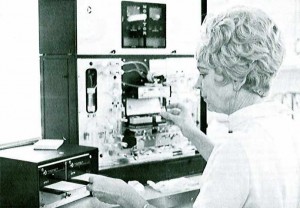-
#ThrowbackThursday: Hematology Laboratory’s New ‘Counter’ Cuts Routine Test Time

This article first appeared Feb. 19, 1971 in the publication Mayovox.
The Routine Hematology Laboratory last week put into service a new instrument—the Coulter Model S—which automatically determines red and white cell counts, hemoglobin, hematocrit, mean cell volume, mean cell hemoglobin and mean cell hemoglobin concentration.
All seven determinations are made on a single 1.3 ml. blood sample and the results are automatically imprinted on a form which is attached to the patient’s chart. A carbon copy of the report is also made which is retained in the laboratory. Samples may be introduced into the instrument at the rate of two to three per minute.
Automation is not new to the Hematology Laboratory. Use of earlier model Coulter Counters for red and white blood cell count was started about ten years ago and represented a vast improvement over the procedure by which a technician literally counted the number of cells visualized through a microscope. However, to secure all of the results obtained in less than a minute with the Model S required approximately 8 minutes with the earlier automatic methods.
The new instrument, in effect, incorporates the measuring devices of six Coulter Counters. The instrument aspirates 1.3 ml. of blood from the sample tube. Most of this blood is used to flush out the previous sample from the system and only a small portion of it is used for the determinations. The blood is diluted and mixed within the diluter module and is propelled through the system by a pneumatic power supply. Measuring devices respond with signals which are translated electronically into numbers which appear on the imprinted form.
The instrument has safety devices to insure accuracy. The values it reports represent the average of three determinations. If the average cannot be made because of mechanical failure a red light appears and the printout gives zero values. Visual indications of all operating functions are provided on the front panel of the diluter module so that the source of any malfunction can be quickly determined and corrected.
The Model S was thoroughly evaluated in the laboratory over a six-month period and was proved to be dependable, fast and precise. Reproducibility of determinations of hemoglobin concentration, hematocrit and red and white cell counts was excellent.
Determinations to be performed on the Coulter S number between 500 and 700 a day and the new instrument will improve capacity to meet peak demands.
Coulter Model B instruments are still used in the laboratory for platelet determinations, and sedimentation rates are determined by manual methods. Differential counts and reticulocyte counts are still made by microscope visualization. Twenty-six technicians are assigned to the laboratory which is staffed until 11 p.m.
Laboratory supervisor is Mrs. Esther (Eppie) McFarland and Robert Johnson is assistant supervisor. Consultants primarily concerned with this hematology laboratory are Drs. Michael B. O’Sullivan, Robert V. Pierre and James W. Linman.
Related Articles







